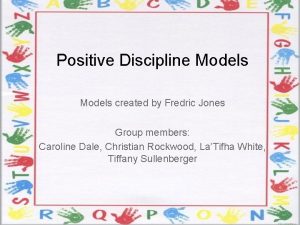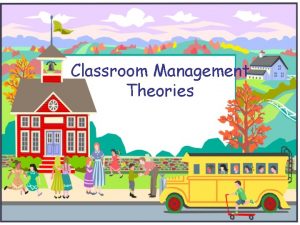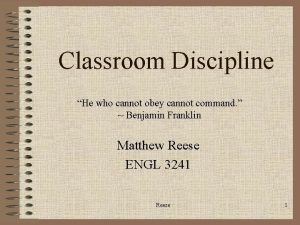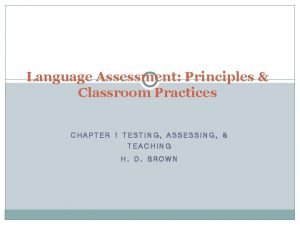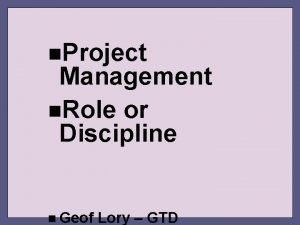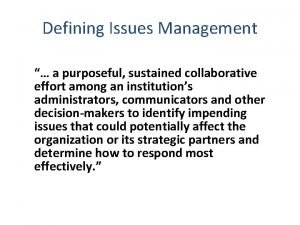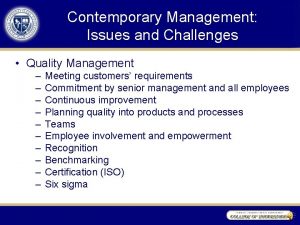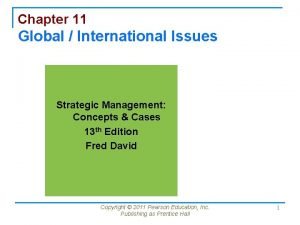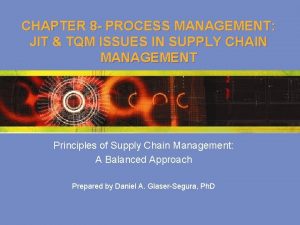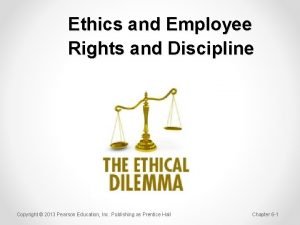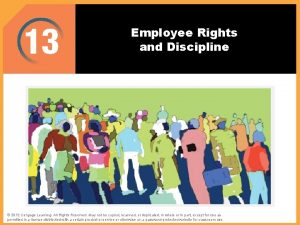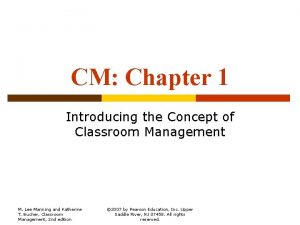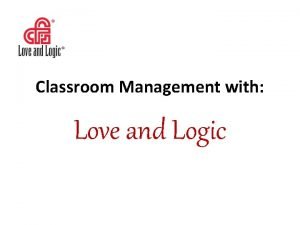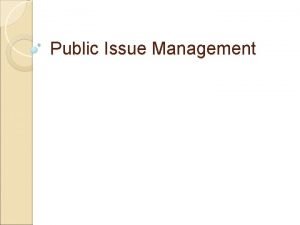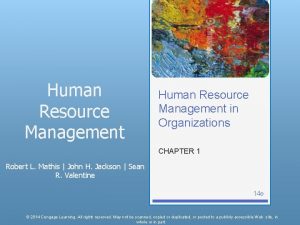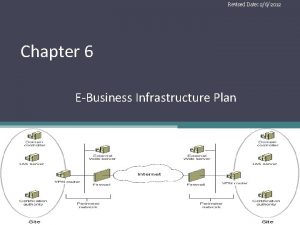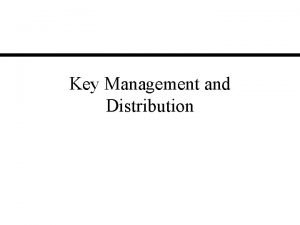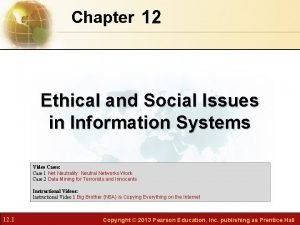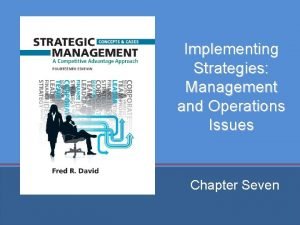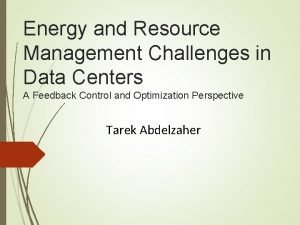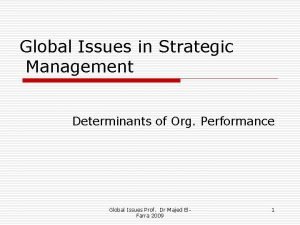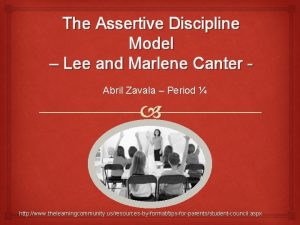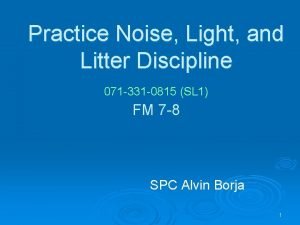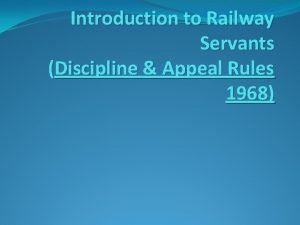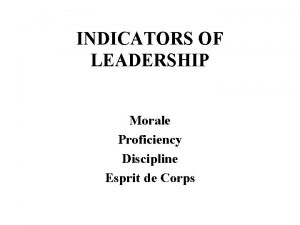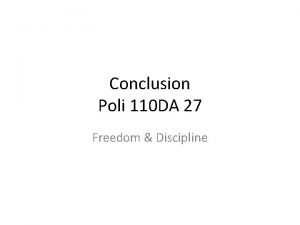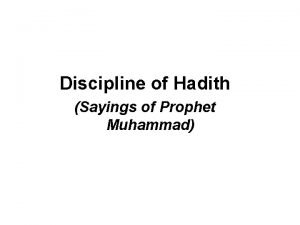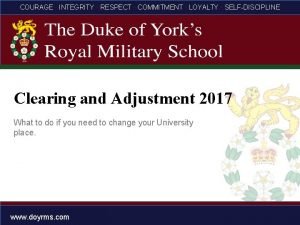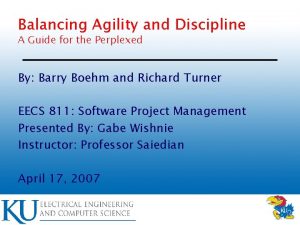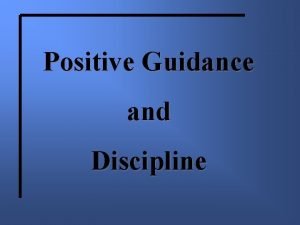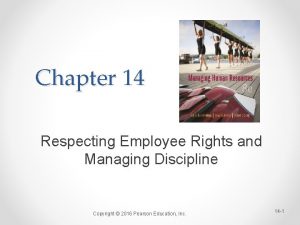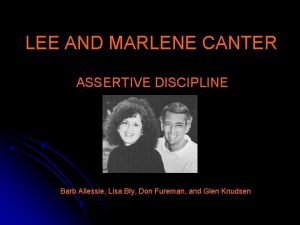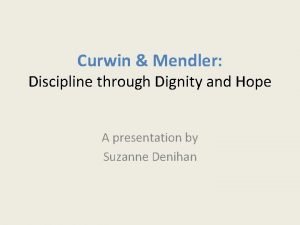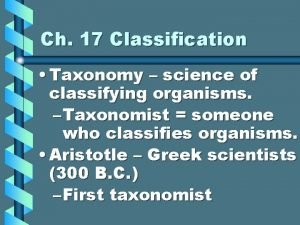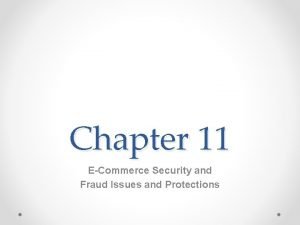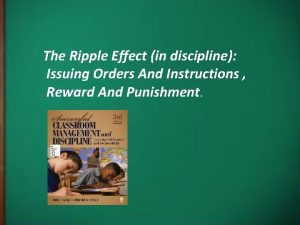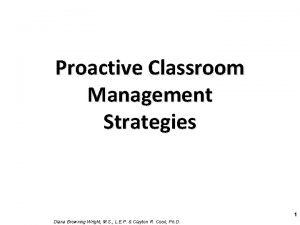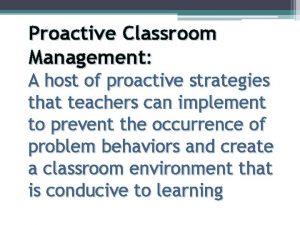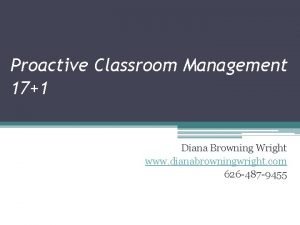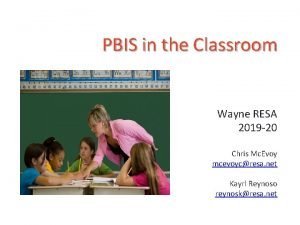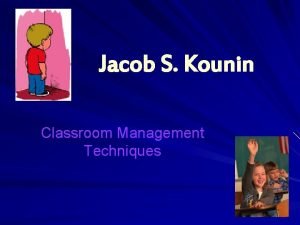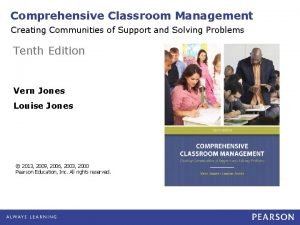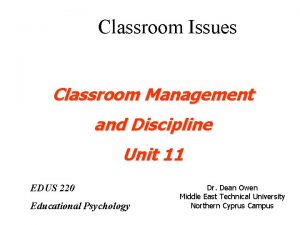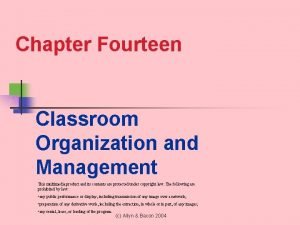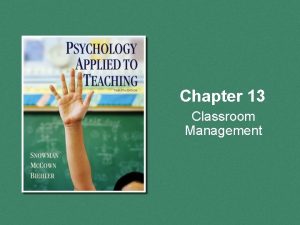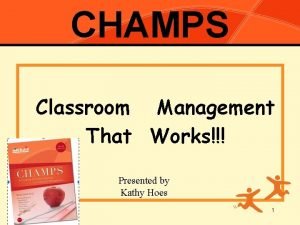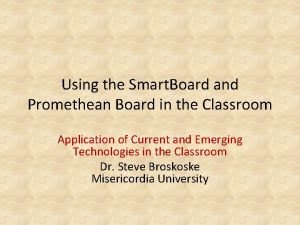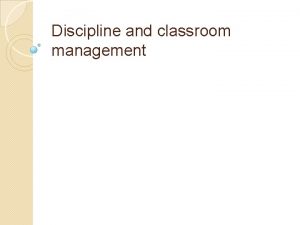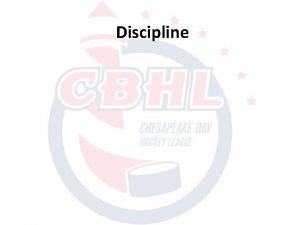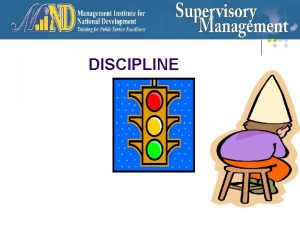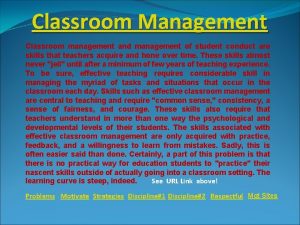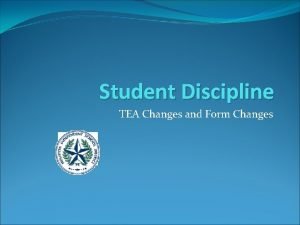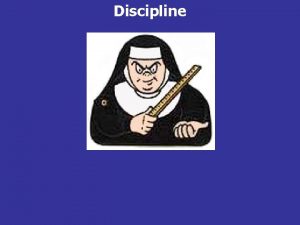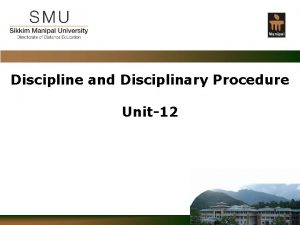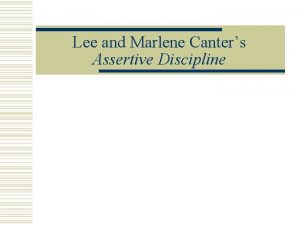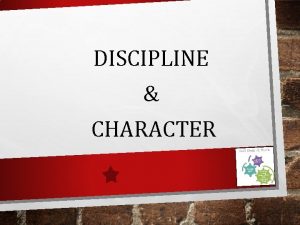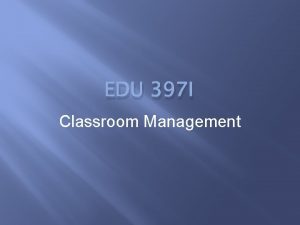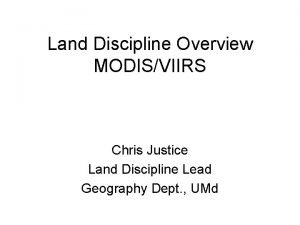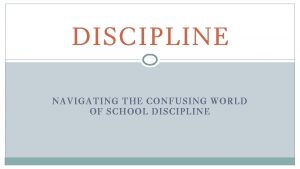Classroom Issues Classroom Management and Discipline Unit 11

















































































- Slides: 81

Classroom Issues Classroom Management and Discipline Unit 11 EDUS 220 Educational Psychology Dr. Dean Owen Middle East Technical University Northern Cyprus Campus

Think back across your life and to the classes you’ve taken. Which one(s) stand out in your memory? Take a moment and write down some adjectives that would describe that course…. .

How would you define the ideal classroom? What would it look like? How many students would you have? What would those students be like?

According to Fred Jones' Positive Classroom Discipline, "The most widespread management technique at home and in the classroom is nag, nag. " It's also the least effective…. .

Classroom Management: How would you define it? 1. The process of ensuring that classroom lessons run smoothly despite disruptive behavior by students. 2. The prevention of disruptive behavior in classrooms.

Classroom Management: Definitions Curriculum refers to what is to be taught. Sources include state and local boards of education, professional associations, textbooks, teacher preferences, and increasing influence from the federal government.

Classroom Management: Definitions Instruction A) What the teacher does! It is the teacher's responsibility to make the curriculum interesting, relevant, meaningful, and/or even fun. Activities that create interest, challenge, inspire creativity or are personal are excellent approaches. A good starting point is for the teacher to ask, "Why am I teaching this? “ and then share the reasons with students. Hint: Every lesson should have planned time for reflection in order to enhance understanding, reinforcement, and retention.

Classroom Management: Definitions Instruction A) What the teacher does (just a few ideas for you) You can’t teach someone against their will!

Classroom Management: Definitions Instruction A) What the teacher does (just a few ideas for you) Teaching is the process of creating “magic” in the classroom…. creating situations in which “learning” is likely to occur.

Classroom Management: Definitions Instruction A) What the teacher does (just a few ideas for you) Teaching is like making a trip…. the teacher is the guide and the students are the hikers……

Classroom Management: Definitions Instruction A) What the teacher does (just a few ideas for you) It’s easier to walk through the forest with someone than to drag that individual, kicking and screaming, through the forest.

Classroom Management: This is one approach

Classroom Management: This is another

Classroom Management: Definitions Instruction B) What students do: Learning that is retained requires participation.

Classroom Management: Definitions Consider the following regarding retention: We remember: 10% of what we read 20% of what we hear 30% of what we see 50% of what we see and hear 70% of what we say 90% of what we say and do

Classroom Management: Definitions Classroom management deals with how things are done. It has to do with procedures, routines, and structure.

Classroom Management: Definitions It is enhanced when procedures are: 1. Explained to students, 2. Modeled for students, 3. Practiced by students, and periodically (when necessary) 4. Reinforced by practicing again 5. When procedures are learned, routines are 6. established. Routines give structure to instruction. Classroom management is the teacher's responsibility.

Classroom Management: Definitions Discipline is the student's responsibility. Discipline deals with how people behave. It is about impulse management and self-control. Consider the difference between discipline and punishment…. . I disciplined (punished) him for being late……(negative meaning…. ) I taught him discipline (self and impulse control) so he could be a better student. (positive meaning…. a gift)…. .

Classroom Management: Scope of the problem According to Moskowitz & Hayman (1976), once a teacher loses control of their classroom, it becomes increasingly more difficult for them to regain that control.

Classroom Management: Scope of the problem Research from Berliner (1988) and Brophy & Good (1986) shows that the time that teacher has to take to correct misbehavior caused by poor classroom management skills results in a lower rate of academic engagement in the classroom.

Classroom Management: Scope of the problem From the student’s perspective, effective classroom management involves clear communication of behavioral and academic expectations, as well as a cooperative learning environment

Classroom Management: Scope of the problem In repeated national studies more than 1/3 of all working teachers said that if they had to choose again, they would not elect to become teachers and the major reason was the difficulty in dealing with difficult students.

Classifications of difficult students Disruptive

Classifications of difficult students Uncooperative

Classifications of difficult students Unmotivated students.

Classroom Management: Approaches Classroom Management Reactive Corporal Punishment Rote Discipline Humiliation Proactive Prevention

Reactive Approaches

Corporal Punishment From the Latin “corpus” meaning the body…. .

Rote Discipline: Sanctions or Writing lines

Humiliation or Public Ridicule

Isolation or “time out”

Student punishment takes many forms…. .

Student punishment takes many forms…. . Punishment is very effective…. . but two conditions must be present… 1. The punishment or level of discomfort must be severe……. 2. The punishment must occur immediately after the offending behavior…. . 3. Neither of these are possible in schools….

Behavioral Approaches Classroom Management Remember learning theory? ? ? How can learning theory be used to improve the classroom climate or behavior in the classroom…. ? ? ? Let’s make a list of behaviors that would be a problem in a classroom…

Some basic learning ideas…. There are three approaches that could be taken in terms of modifying behavior. . 1. Increase a current behavior……I know how to do it…I just need to do it more, faster, better, more often…. etc….

Some basic learning ideas…. There are three approaches that could be taken in terms of modifying behavior. . 2. Decrease a current behavior: I can do it but I need to it less often, with lower intensity……

Some basic learning ideas…. There are three approaches that could be taken in terms of modifying behavior. . 3. Teach a new behavior: I need to learn an entirely new behavior to make myself more effective or more coping…. .

Preventative Approaches to Classroom Management

An old saying: A ounce of prevention is worth a pound of cure Metric version A gram of prevention is worth a kilogram of cure

Preventative approaches focus on the development of a positive classroom community in which there is mutual respect between students and teacher.

The Good Behavior Game Description: The Good Behavior Game is an approach to the management of classrooms behaviors that rewards children for displaying appropriate on-task behaviors during instructional times. How it is played: The class is divided into two teams and a point is given to a team for any inappropriate behavior displayed by one of its members. The team with the fewest number of points at the Game's conclusion each day wins a group reward. If both teams keep their points below a preset level, then both teams share in the reward. The program was first tested in 1969; several research articles have confirmed that the Game is an effective means of increasing the rate of ontask behaviors while reducing disruptions in the classroom (Barrish, Saunders, & Wolf, 1969; Harris & Sherman, 1973; Medland & Stachnik, 1972).

Token Economies in classrooms……

The Good Behavior Game The Five Basic Steps…. . Step 1: Decide when to schedule the Game. The teacher first decides during what period(s) of the school day the Game will be played. As a rule of thumb, instructors should pick those times when the entire class is expected to show appropriate academic behaviors. Blocks of time devoted to reading, math, content instruction, and independent seatwork would be most appropriate for putting the Game into effect. Step 2: Clearly define the negative behaviors that will be scored during the Game. Teachers who have used the Good behavior Game typically define three types of negative behavior that will be scored whenever they appear during the Game. Those behaviors are: /p> leaving one's seat, talking in class , and engaging in disruptive behavior (Offtask behavior).

The Good Behavior Game The Five Basic Steps…. . Step 3: Selecting Rewards that fit. Must be desired or valued by students Must satisfy a fundamental need of students…. primary: Food…pizza Secondary: Recognition, attention, free related topics. Must fit naturally into the classroom…. additional time on the computer, or free reading time…. or play time…. or extra class time on skill building games and activities…

The Good Behavior Game The Five Basic Steps…. . Step 4: Introduce the Game to the class Once behaviors have been selected and clearly defined by the teacher, the next step is to introduce the Game to the class. Ideally, time should be set aside for an initial group discussion. The teacher mentions that the class will be playing a game and presents a schedule clearly setting forth the instructional times during which the game will be in effect. The teacher next divides the classroom into two teams. For ease of recording, it is usually recommended that the instructor divide the class down the center of the room into roughly equal halves. Some teachers have used three teams successfully as well. To build a sense of team spirit, students may be encouraged to name their groups.

The Good Behavior Game The Five Basic Steps…. . Step 5: Put the Game into effect. The game should have a definite start and stop time…. The instructor should continue normal classroom activities…the only change is that the instructor is also noting and publicly recording any negative points incurred by either team. Team scores should be posted where everyone can see them…. Game can be played over the a day, week, month…. . Care should be taken to be as consistent as possible in scoring negative behaviors. Winning teams should be praised as well as rewarded for their efforts, with that praise tied when possible to specifically observed behaviors.

Discipline with Dignity According to its founders, Discipline with Dignity is one of the most widely practiced behavior management philosophies in the world. Founded by Dr. Richard Curwin and Dr. Allen Mendler, the program is utilized in more than 12 different countries. Discipline with Dignity, provides an in-depth flexible approach for effective school and classroom management. With a strong focus on developing responsibility, it is a comprehensive, practical program that leads to improved student behavior through responsible thinking, cooperation, mutual respect, and shared decision-making. Social Contract between Teacher and Students….

Discipline with Dignity Basic Principles: • • Long-term behavioral change, not quick fixes Dealing with student behavior is part of the job Rules must make sense Be a model of what you expect Always treat students with dignity Responsibility is more important than obedience Stop doing ineffective things You can be fair without always having to treat every one the same

Discipline with Dignity Basic Principles: In disciplining difficult to control students Curwin and Mendler believe teachers need to use the following principles: 1) Dealing with student behavior is an important part of teaching. They should put as much effort into teaching good behavior as they put into teaching content. 2) Always treat students with dignity. To treat students with dignity is to be concerned about and understanding of their needs and viewpoints. Curwin and Mendler advise teachers to ask themselves this question when reacting to student misbehavior: "How would this strategy affect my dignity if a teacher did it to me? "

Discipline with Dignity Basic Principles: 3) Good discipline must not interfere with student motivation. Any discipline technique is self-defeating if it reduces motivation to learn. 4) Responsibility is more important than obedience. Obedience means "do as you are told. " Responsibility means "make the best possible decision. "

Sample Contract How to Succeed in Mrs. Golubtchik's Class Welcome to math class. The success we shall experience together is directly proportional to the effort we put into this class. Rights and Responsibilities 1. You have the right to a safe and orderly classroom. Every effort will be made to provide an atmosphere that promotes learning. 2. You are responsible for being a good citizen in our classroom community. A good citizen: a. Respects the rights of others. b. Respects the property of others. c. Recognizes that there can be more than one acceptable point of view. d. Listens to others with respect. e. Disagrees appropriately. f. Accepts constructive criticism. g. Observes the rules of safety and classroom management. h. Maintains a positive self-concept.

Contract continued…. 3. You are responsible to come to class on time prepared to begin work. 4. You must provide your own notebook, pens, and pencils. 5. A folder to hold your work will be given to you. 6. If you are absent, it is your responsibility to make up the assignments. 7. If you have a question or problem, please talk to me or write me a note. I can be flexible if I understand the situation.

Grading Policy 1. Everything you do in class counts toward your grade. Your grade will be based on three important components: a. 1/3 of your grade will be based on assignments, including all classwork, journals, and homework. Your teacher will work with you on a reasonable calendar of assignments. b. 1/3 of your grade will be based on your grades on quizzes and tests. c. 1/3 of your grade will be based on your behavior and social interaction. This will include Punctuality, Being Prepared, Cooperation and Respect, Quality of Work, Conduct, and Homework. You will be graded on these items each day. This is a good way to improve your mark. 2. Bonus points will be given often. They can improve your grade and give you extra rewards and privileges. You can earn bonus points by: a. Performing Random Acts of Kindness. b. Helping another student. c. Asking an especially thoughtful question. d. Giving a very clever and intelligent answer. e. Performing a classroom duty.

3. Each marking period will be averaged into the next. Everything counts. 4. You have the "Power of Choice" to make good decisions. Every effort will be made to provide greater levels of responsibility to those who have earned it. Let's make this a fun term! Sincerely, Mrs. Golubtchik I have read this document and agree to its terms. _________________________ Signature of student __________________________ Signature of parent __________________________ Signature of teacher

National Educational Association Four Areas of Classroom management Begin by considering the following four areas of classroom management: Establishing classroom climate -- the look and feel of your room Conducting class efficiently -- managing time and students Reaching all students -- delivery, encouragement, teaching techniques Establishing discipline -- creating an atmosphere of consistency and mutual respect

Establishing Classroom Climate To create the climate you want for your classroom, you must first decide the look and feel of the room. Think about the types of activities that will go on in your classroom as you answer the following questions: Can you tolerate noise? Must the room always be quiet? Or can you put up with a mix of noise and quiet, depending on the learning activity? It's easier to start out more controlled and gradually open up to activity and noise than the other way around. Must your classroom be neat (orderly rows, clean boards, limited clutter) or can you stand it messy? What do you want your desk and surroundings to say about you? I'm neat and efficient. I don't worry about clutter, but I like some order. I like flowers and color. I value students' work and enjoy displaying it. How do you want students to turn in their work? Do you want them to put it into your hands, into baskets, or e-mail it to you? Let them know. Tell students how you feel about classroom climate and how everyone can help maintain a pleasant, productive learning environment.

Conducting Class Efficiently When you streamline classroom procedures, you make things clearer for everyone and you make more time for teaching and learning. An efficiently run classroom enables students to focus on their work, which, in turn, helps reduce discipline problems. To streamline your classroom procedures, use the following approaches: Set long-term goals and keep them in mind as you do your daily planning. Quickly learn and use student names. Gain students' attention before beginning a new activity. Don't try to talk over student noise. Give students their next assignment before you collect or return papers.

Conducting Class Efficiently Give students their next assignment before you collect or return papers. Don't interrupt students while they are on task. Edit any materials you write for students. On tests be sure to avoid using poorly worded, ambiguous questions. Don't introduce too many topics simultaneously. Think through the delivery of content before you get to the classroom. Think through directions you will give students (write them down, if that helps, before giving them verbally). Directions should be brief, and as the word implies, direct. Don't stretch out the time for an activity. Be consistent in what you say and what you do.

Reaching All Students Three strategies will help you teach and reach all students. Vary your delivery to keep students awake and interested in learning. Encourage all students to do their best and let them know that you believe they can succeed. Apply proven teaching techniques to keep student interest and monitor whether they are learning. Vary Your Delivery Modulate your voice. Avoid speaking too fast or in a high-pitched tone. Use a voice level that can be heard easily in the back of the room. Be animated in your delivery. Using facial expressions and body language can be very effective in teaching. Move around. Don't stand or sit too long in one place.

Reaching All Students Encourage All Students Accentuate the positive. Be serious about getting work accomplished, but add some humor and fun to class each day. Let students know that you expect them to succeed. Talk to and interact with as many students as possible, not just your favorite students.

Reaching All Students Apply Proven Teaching Techniques Vary your teaching strategies or combination of strategies during the week. Use three or more seconds of "wait-time" after asking a content question. Balance the time you spend with one student or group and monitoring the entire class. Do appropriate comprehension checks -- as you are teaching -- to see if students understand the content. Praise students appropriately. If you praise them all the time -- especially when they're only doing what's expected and no more, they won't strive to do more. Remember, intermittent reinforcement is the most powerful way to reinforce positive behavior. Be selective in your praise. Be honest. Tell them when they've excelled and how they can improve. Read student papers for correct answers and for process and student thinking.

Establishing Discipline When you establish an atmosphere of consistency and mutual respect, you will eliminate some discipline problems and facilitate the solving of others. Here are some techniques to use: Be consistent in what you say and what you do. Quickly learn and use student names. Find an effective means of quieting students. Instead of saying "Shhh, " consider using a subtle strategy such as dimming the lights, playing classical or other soothing music, or putting on the board a problem, a brainteaser, or an intriguing question relating to the lesson of the day.

Establishing Discipline Avoid using threats to control the class. If you do use a threat, be prepared to carry it out. Nip behavior problems in the bud. Intervene quickly when students are behaving inappropriately. Whenever possible, reprimand a student one-on-one instead of across the room, in front of the whole class. Don't permit students to be inattentive to an educationally useful media presentation. Use appropriate punishment for classroom misbehavior.

Positive Classrooms, developed by Dr. Robert Di. Giulio. The program sees positive classroom management as the result of four factors: 1. How teachers regard their students (spiritual dimension), (? ) 2. how they set up the classroom environment (physical dimension), (? ) 3. how skillfully they teach content (instructional dimension), (? ) and 4. how well they address student behavior (managerial dimension). (? )

Assertive Discipline This systematic approach to classroom management is the result of work by Lee and Marlene Canter who studied master teachers to determine patterns associated with good and effective classroom setting. Master teachers are assertive; they • teach students how to behave. • established clear rules for the classroom, • communicate those rules to the students, and • they teach the students how to follow them. Master teachers effectively use positive reinforcement, and they praise every student at least once a day. Finally, when students chose to break the rules, these teachers used firm and consistent negative consequences ‑ but only as a last resort.

Classroom management as time management In their introductory text on teaching, Kauchak and Eggen (2008)[14] explain classroom management in terms of time management. The goal of classroom management, to Kauchak and Eggen, is to not only maintain order but to optimize student learning. They divide class time into four overlapping categories, namely allocated time, instructional time, engaged time, and academic learning time. Allocated time is the total time allotted for teaching, learning, and routine classroom procedures like attendance and announcements. Allocated time is also what appears on a student's schedule, for example "Introductory Algebra: 9: 50 -10: 30 a. m. " or "Fine Arts 1: 15 -2: 00 p. m. " Instructional time is what remains after routine classroom procedures are completed. That is to say, instructional time is the time wherein teaching and learning actually takes place. Teachers may spend two or three minutes taking attendance, for example, before their instruction begins. Engaged time is also called time on task. During engaged time, students participating actively in learning activities—asking and responding to questions, completing worksheets and exercises, preparing skits and presentations, etc. Academic learning time occurs when students 1) participate actively and 2) are successful in learning activities. Effective classroom management maximizes academic learning time.

Some Concluding suggestions Understand the function of misbehavior…. . It’s not always about YOU…. . Stop thinking: Look at what this kid is doing TO me Start thinking: What is this kid doing for himself…. the student is usually filling a need…. .

Some Concluding suggestions Definition of insanity: Doing the same thing over and expecting a different result. If an approach is not working…. do continue to do it…. doing it longer, louder or stronger will probably not help…. do something different!

Some Concluding suggestions Set reasonable rules, communicate them clearly and enforce them equally and consistently….

Some Concluding suggestions Make students part of the solution! The teacher should be in control…but get help from the students…. a job is always easier if more people help! Invite students to help create rules and enforcement procedures…. . peer pressure is not just for clothes, music, drugs, sex, and rock ‘n roll……. Peer pressure can be a very powerful and positive force in a classroom!

Conclusion Howard Miller, Associate Professor of Education at Lincoln University, has established 12 steps for the beginning of the year to help teachers promote effective classroom management. These are as follows (taken from Creating a Climate for Learning: Effective Classroom Management Techniques): 1. Develop a set of written expectations you can live with and enforce. 2. Be consistent. 3. Be patient with yourself and with your students. 4. Make parents your allies. Call early and often. Use the word "concerned. " When communicating a concern, be specific and descriptive.

5. Don't talk too much. Use the first 15 minutes of class for lectures or presentations, then get the kids working. 6. Break the class period into two or three different activities. Be sure each activity transitions smoothly into the next. 7. Begin at the very beginning of each class period and end at the very end. 8. Don't roll call. Take the roll with your seating chart while students are working.

9. Keep all students actively involved. For example, while a student does a presentation, involve the other students in evaluating it. 10. Discipline individual students quietly and privately. Never engage in a disciplinary conversation across the room. 11. Keep your sense of perspective and your sense of humor. 12. Know when to ask for help.

A PARENT/STUDENT/TEACHER COMPACT (Agreement) John Sipp, a Title 1 Specialist at Rocky Heights Elementary School in Hermiston, Oregon, says teachers there have found that rules are most effective when teachers, parents, and students are equally committed to upholding them. At the start of each school year, a compact spelling out their specific responsibilities is signed by each of the parties involved. Sipp has been kind enough to share that compact with Education World. The text of the compact follows.

As a parent/guardian, I will: Show respect and support for my child, the teachers, and the school. Support the school's discipline policy. Provide a quiet, well-lit place for study and supervise the completion of homework. Attend parent-teacher conferences. Talk with my child each day about his or her school activities. Monitor my child's TV viewing. Assist with at least one school or classroom activity. Read with my child for at least 10 minutes each day and let my child see me read.

As a student, I will: Always try to do my best work. Be kind and helpful to my classmates. Show respect for myself, my school, and other people. Obey classroom, school, and bus rules. Show respect for property by not stealing or vandalizing. Come to school prepared with my homework and my supplies. Believe that I can and will learn. Spend at least 15 minutes each day studying or reading at home. Talk with my parents each day about my school activities.

As a teacher, I will: Show respect for each child and for his or her family. Make efficient use of learning time. Provide a safe and comfortable environment that's conducive to learning. Help each child grow to his or her fullest potential. Provide meaningful and appropriate homework activities. Provide necessary assistance to parents so they can help with assignments. Enforce school and classroom rules fairly and consistently. Supply students and parents with clear evaluations of progress and achievement. Use special activities in the classroom to make learning enjoyable. Demonstrate professional behavior and a positive attitude.

Now, hand in hand, we will work together to carry out this contract. Signed: _______________ Parent signature/date _______________ Student signature/date _______________ Teacher signature/date

School Climate Factors Artifacts and symbols The building and its arrangements reflect the children, their needs, and their educational accomplishments. Artifacts and Symbols There is little that reflects an emphasis on children and their education. Values Administrators, teachers, students, and parents participate in decision making. Values Decisions are made without participation of teachers and parents. Assumptions and beliefs All students can learn. Parents want their children to succeed. Parents are partners in education. Assumptions and beliefs Some students are incapable of learning or too lazy to learn. Parents don’t care. Parents know nothing about education. Source: Best Practice Briefs, University of Michigan, 2004

References Wolfgang, C. H. & Glikman, C. D. (1986). Solving Discipline Problems : Strategies for classroom teachers, (2 nd ed). Newton, MA: Allyn and Bacon Berliner, D. C. (1988). Effective classroom management and instruction: A knowledge base for consultation. In J. L. Graden, J. E. Zins, & M. J. Curtis (Eds. ), Alternative educational delivery systems: Enhancing instructional options for all students (pp. 309 -325). Washington, DC: National Association of School Psychologists. Brophy, J. E. , & Good, T. L. (1986). Teacher behavior and student achievement. In M. C. Wittrock (Ed. ), Handbook of research on teaching (3 rd ed. , pp. 328 -375). New York: Macmillan. Barrish, H. H. , Saunders, M, & Wold, M. M. (1969). Good behavior game: Effects of individual contingencies for group consequences on disruptive behavior in a classroom. Journal of Applied Behavior Analysis, 2, 119 -124. Harris, V. W. & Sherman, J. A. (1973). Use and analysis of the "Good Behavior Game" to reduce disruptive classroom behavior. Journal of Applied Behavior Analysis, 6, 405 -417. Medland, M. B. & Stachnik, T. J. (1972). Good-behavior Game: A replication and systematic analysis. Journal of Applied Behavior Analysis, 5, 45 -51.

 Jones model classroom management
Jones model classroom management Ginott model of classroom discipline
Ginott model of classroom discipline Types of discipline
Types of discipline Language assessment: principles and classroom practices
Language assessment: principles and classroom practices Current issues in classroom testing
Current issues in classroom testing Sourima mal
Sourima mal Unit 6 review questions
Unit 6 review questions Project management discipline
Project management discipline Jones and chase issues management model
Jones and chase issues management model Contemporary management issues and challenges
Contemporary management issues and challenges Chapter 7 strategic management
Chapter 7 strategic management Implement strategies management issues
Implement strategies management issues Chapter 7 strategic management
Chapter 7 strategic management Global international issues in strategic management
Global international issues in strategic management Process management in tqm
Process management in tqm Matching structure with strategy
Matching structure with strategy Implementing strategies management and operations issues
Implementing strategies management and operations issues Ethics and employee rights and discipline
Ethics and employee rights and discipline Ethics and employee rights and discipline
Ethics and employee rights and discipline Dreikurs classroom management theory
Dreikurs classroom management theory Love and logic enforceable statements
Love and logic enforceable statements Contemporary
Contemporary What are the functions of public issue management
What are the functions of public issue management Issues management in public relations
Issues management in public relations Current issues in human resource management
Current issues in human resource management Global international issues in strategic management
Global international issues in strategic management E business infrastructure
E business infrastructure Major issues with kdc
Major issues with kdc E-business infrastructure
E-business infrastructure Why study operations management
Why study operations management Social issues in technology management
Social issues in technology management Management issues central to strategy implementation
Management issues central to strategy implementation Data center management issues
Data center management issues System design in operations management
System design in operations management Global issues in strategic management
Global issues in strategic management Top management and middle management
Top management and middle management Management pyramid
Management pyramid Basic concepts of management
Basic concepts of management Lee canter theory
Lee canter theory Veterinary nurse conduct and discipline rules 2014
Veterinary nurse conduct and discipline rules 2014 Litter discipline
Litter discipline Discipline objectives
Discipline objectives Railway discipline and appeal rules book
Railway discipline and appeal rules book Morale indicators
Morale indicators Christian domestic discipline examples
Christian domestic discipline examples Conclusion of freedom and discipline
Conclusion of freedom and discipline Courtesy reflects a positive attitude
Courtesy reflects a positive attitude Discipline with dignity core beliefs
Discipline with dignity core beliefs Discipline in quran and hadith
Discipline in quran and hadith School integrity, commitment and loyalty are
School integrity, commitment and loyalty are Balancing agility and discipline
Balancing agility and discipline Positive guidance and discipline
Positive guidance and discipline The discipline that deals with what is good and bad
The discipline that deals with what is good and bad Respecting employee rights and managing discipline
Respecting employee rights and managing discipline In the discipline of taxonomy what is a domain
In the discipline of taxonomy what is a domain Lee and marlene canter biography
Lee and marlene canter biography Curwin and mendler
Curwin and mendler Discipline of classifying and naming organisms
Discipline of classifying and naming organisms Discipline of classifying and naming organisms
Discipline of classifying and naming organisms What is the hierarchical system used to classify organisms?
What is the hierarchical system used to classify organisms? Legal ethical and societal issues
Legal ethical and societal issues Ecommerce security issues
Ecommerce security issues Professional issues in cyber security
Professional issues in cyber security Hyp opp adj triangle
Hyp opp adj triangle Unit process and unit operation
Unit process and unit operation Difference between unit process and unit operation
Difference between unit process and unit operation Jacob kounin
Jacob kounin 17 proactive classroom management strategies
17 proactive classroom management strategies Proactive classroom management
Proactive classroom management 17 proactive classroom management strategies
17 proactive classroom management strategies Wayne resa pbis
Wayne resa pbis Development plan for teachers
Development plan for teachers Elements of effective classroom management
Elements of effective classroom management Daniel kounin
Daniel kounin Jacob s kounin
Jacob s kounin Comprehensive classroom management
Comprehensive classroom management Rote discipline
Rote discipline Classroom dimensions
Classroom dimensions Antiseptic bouncing
Antiseptic bouncing Champs behavior plan
Champs behavior plan Promethean board vs smartboard
Promethean board vs smartboard Jones theory of classroom management
Jones theory of classroom management
